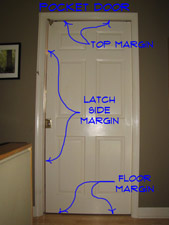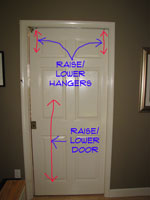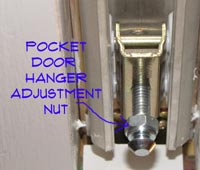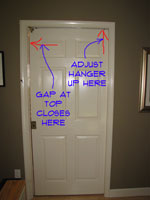 A common problem with pocket doors is difficulty getting the door to latch. The locksets for pocket doors are pretty sensitive and do not allow much of a margin for error. Pocket door adjustment is needed to correct height and alignment issues. When you are working on a latch, the height is a critical concern.
A common problem with pocket doors is difficulty getting the door to latch. The locksets for pocket doors are pretty sensitive and do not allow much of a margin for error. Pocket door adjustment is needed to correct height and alignment issues. When you are working on a latch, the height is a critical concern.
Not sure if this is your problem? See the articles, 'Troubleshooting Pocket Doors' and 'Pocket Door Off Track' for some common pocket door probems. For a discussion on common door problems, see 'Fixing Residential Doors'.
Troubleshooting Pocket Door Adjustment Problems
To adjust the latch, you need to get the height of the door lined up with the strike plate correctly. See next section for instructions.
When the catch won't engage it usually means that the strike plate and the catch are not aligned properly.
Bring the door as close as you can to the strike plate and work the lock to see whether the tongue on the catch is too high or too low. The catch acts like a hook to hold the door closed when it is engaged.
If your door is too low, possibly scraping the floor, you will need to raise it. You will need to be careful, too much change in the height of the door may cause the pocket door latch to not work.
When the door has a gap along the side, the adjustments can get a little tricky. You need to understand how the door reacts when you raise or lower only one side. See the heading 'Adjusting Pocket Door Side Margins', below.
Pocket Door Height Adjustment
 The way that a pocket door is installed allows for adjustments on the height. A standard hinged door cannot be adjusted this way.
The way that a pocket door is installed allows for adjustments on the height. A standard hinged door cannot be adjusted this way.
You need a wrench to adjust the hangers on a pocket door. There is a relatively narrow space at the top of the door where the nut is on the hanger. Most pocket doors will have two hangers. See 'Pocket Door Wrenches' and 'Pocket Door Hangers' for additional information.
Turning the nut clockwise will raise the door and counterclockwise will lower it. When you are adjusting the height you want to turn each nut the same amount. Rasing one hanger more or less than the other one will cause the door to be crooked in the opening.
Turn each nut one full turn and check you height. Continue to raise or lower the door until the desired height is reached.
 Be careful when you raise or lower the door, it may affect the operation of the pocket door latch. Raising the door may seem like a logical choice when you add new flooring. However, raising it that much will likely cause the lockset to stop working. It is better to trim the door at the bottom, instead of trying to raise it.
Be careful when you raise or lower the door, it may affect the operation of the pocket door latch. Raising the door may seem like a logical choice when you add new flooring. However, raising it that much will likely cause the lockset to stop working. It is better to trim the door at the bottom, instead of trying to raise it.
Adjusting Pocket Door Side Margins
 The side adjustments on a pocket door work differently than you might think. If the gap in your door is not too bad, you are only going to want to adjust one of the hangers on the door, preferably the one farthest from the door latch. See 'Pocket Door Wrenches' and 'Pocket Door Hangers' for additional information.
The side adjustments on a pocket door work differently than you might think. If the gap in your door is not too bad, you are only going to want to adjust one of the hangers on the door, preferably the one farthest from the door latch. See 'Pocket Door Wrenches' and 'Pocket Door Hangers' for additional information.
The gap along the side of the door is going to be at either the top or the bottom. I will describe this with words, but you want to look at the pictures to get a sense of what is happening.
 If the gap is at the top of the door, you want to raise the door at the hanger that is farthest away from the latchset. Use the pocket door wrench and turn it one quarter to one half turn at a time until the door is parallel with the jamb.
If the gap is at the top of the door, you want to raise the door at the hanger that is farthest away from the latchset. Use the pocket door wrench and turn it one quarter to one half turn at a time until the door is parallel with the jamb.
For a gap at the bottom of the door, you want to do the exact opposite. Lower the door at the hanger that is farthest away from the door latch. This will cause the bottom of the door to move toward the jamb, closing the gap. Turn it one quarter to one half turn at a time until it is aligned properly.
You may need to make some minor adjustments to the height of the door after you have corrected the margin. Check the operation of the lockset and adjust accordingly.
Pocket Door Adjustment Summary
Once your pocket door is adjusted properly, you want to make sure it is latching correctly. See the articles 'Troubleshooting Pocket Door Locks' and 'Pocket Door Guides' for instructions and information.
Adjusting a pocket door is not that difficult if you still have the wrench that came with the door. Once you understand how the door moves, adjustments are easy.

